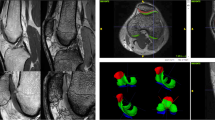Abstract
Knowledge about sequence properties is essential to plan and acquire a diagnostic MRI examination. The broad four categories of sequences include spin echo (SE), gradient echo (GRE), inversion recovery (IR) and echoplanar imaging (EPI). Varieties of sequences from these four categories are available for clinical application. They have different contrast mechanisms, spatial and contrast resolution and speed of acquisition. Choice of sequence differs in various scenarios in clinical practice such as solid organ imaging, moving target imaging, bone and bone marrow imaging, cartilage imaging and vessel imaging, taking into consideration properties of sequences to answer the clinical question. Broad classification of sequences and differences in their contrast, spatial and contrast resolution, and speed of acquisition are discussed in this review. A few common clinical scenarios of MRI imaging are illustrated, along with reasons for the given sequence choices.









Similar content being viewed by others
References
Chavhan GB (2013) MRI made easy, 2nd edn. Jaypee Brothers Medical Publishers, New Delhi, pp 33–46
Nitz WR (1999) MR imaging: acronyms and clinical applications. Eur Radiol 9:979–997
Brown MA, Semelka RC (1999) MR imaging abbreviations, definitions, and descriptions: a review. Radiology 213:647–662
Nitz WR (2002) Fast and ultrafast non-echo-planar MR imaging techniques. Eur Radiol 12:2866–2882
Nitz WR (1999) Contrast mechanisms in MR imaging. Eur Radiol 9:1032–1046
Chavhan GB, Babyn PS, Thomas B et al (2009) Principles, techniques and applications of T2*-based MR imaging and its special applications. Radiographics 29:1433–1449
Chavhan GB, Babyn PS, Jankharia BG et al (2008) Steady-state MR imaging sequences: physics, classification, and clinical applications. Radiographics 28:1147–1160
Chavhan GB, Babyn PS, Vasanawala SS (2013) Abdominal MR imaging in children: motion compensation, sequence optimization, and protocol organization. Radiographics 33:703–719
Erly WK, Oh ES, Outwater EK (2006) The utility of in-phase/opposed-phase imaging in differentiating malignancy from acute benign compression fractures of the spine. AJNR Am J Neuroradiol 27:1183–1188
Chavhan GB, Babyn PS, John P et al (2015) Pediatric body MR angiography: principles, techniques, and current status in body imaging. AJR Am J Roentgenol 205:173–184
Author information
Authors and Affiliations
Corresponding author
Ethics declarations
Conflicts of interest
The author has no financial interests, investigational or off-label uses to disclose.
Rights and permissions
About this article
Cite this article
Chavhan, G.B. Appropriate selection of MRI sequences for common scenarios in clinical practice. Pediatr Radiol 46, 740–747 (2016). https://doi.org/10.1007/s00247-016-3556-4
Received:
Revised:
Accepted:
Published:
Issue Date:
DOI: https://doi.org/10.1007/s00247-016-3556-4




